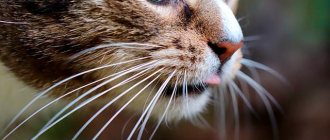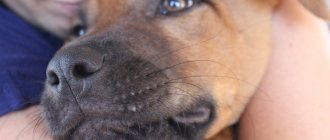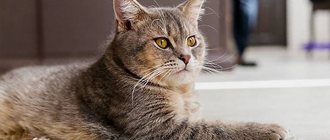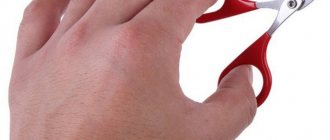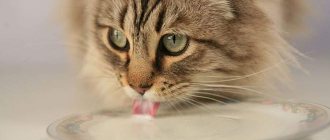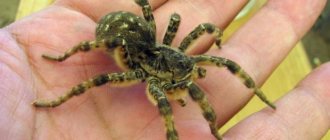(Be the first to vote!)
5589564
06/24/2021 owner reviews
Curious what happens when you trim your cat's whiskers? Find out the role of whiskers in cats and other animals and what happens if they lose them.
Since you are reading this article, you are probably wondering what will happen if you trim or shorten your cat's whiskers. Will this affect the cat's behavior in any way and, most importantly, will it harm the animal? Or are mustaches only for decorative purposes?
To give you a short answer:
Whiskers are not just decorative, and you should never cut or trim the whiskers of a cat or any animal. This will cause discomfort and other problems for the animal.
To get a more detailed answer and learn about the role of whiskers in cats, keep reading.
- What is a mustache?
- The role of whiskers in cats
- What happens after trimming your mustache?
- Does a mustache grow?
- The last word
What are vibrissae?
Contrary to popular belief, the whiskers on the faces of furry pets have nothing to do with decoration. They are endowed with exclusively applied, navigation functions. During evolution, many mammals acquired such a tool. This is especially true for animals living in conditions of limited visibility.
Vibrissae are part of the short-range orientation system
The word “vibrissae” comes from the Latin “vibro”, which means “wriggle”. This term refers to the receptors of the organs of touch.
Main characteristics:
- shape - straight or twisted;
- color - white or black;
- quantity - from 33 to 40;
- length - from 5 to 7 cm;
- location - underpads, chin, cheeks, eyelids, tail, ankles, paw pads.
In representatives of some breeds, for example, the Maine Coon, the length of the whiskers can reach 19 cm. In the Cornish Rex they are small and curled at the ends. Sphinxes are sometimes born without whiskers, which does not prevent them from orienting themselves in space.
Vibrissae structure
One of the distinctive features of tactile hairs is elasticity. This quality is achieved due to the conical narrowing of the vibrissae towards the end. They are rooted in the skin 3 times deeper than wool, which makes it possible to trigger the mechanism for transmitting information coming from outside to the brain. Each whisker has a separate “representation” in the brain, similar to the sense organs.
At the base of the vibrissa there is muscle tissue supplied with a large number of nerve endings. They are connected to a specific part of the brain. The vibration of the hair excites the root, and the impulse is instantly transmitted to the desired section.
Scientists claim that cats' whiskers give them a three-dimensional night vision. Unlike information obtained through hearing, smell or vision, whiskers contribute exclusively to short-range orientation.
Vibrissae help a cat learn about the world around it
Interesting Facts:
- vibrissae are denser than hair;
- controlled by different muscle groups;
- pick up the slightest air vibrations;
- are formed before the fur.
There is a version that hair and whiskers have different evolutionary origins. Tactile hairs appeared in the ancestors of mammals much earlier than wool.
Whiskers are sensitive to negative electrical charges that arise when stroking a cat against the grain.
What disorders are associated with loss of mustache?
The sudden loss of a large number of mustaches is associated with the development of the following diseases:
- vitamin deficiency (lack of vitamin A, D and some microelements in the pet’s body);
- diseases of the thyroid gland (hypothyroidism, hyperthyroidism);
- diabetes;
- allergic reaction to food or certain substances;
- metabolic disease;
- skin diseases.
If a cat loses a significant number of its whiskers by the roots, it must be shown to a veterinarian. Self-medication will worsen your pet's condition.
Why do antennae fall out or break, is this normal?
Even though the structure of a mustache is different from that of regular hair, it can also fall out and break.
Vibrissae have their own lifespan, and after its expiration they leave the follicles. When you see 1-2 fallen antennae, there is no need to sound the alarm, but if there are a lot of them, you need to look for the cause. Often, excessive fragility and loss of whiskers are associated with stress, dehydration or an unbalanced diet that does not provide the animal with the necessary vitamins and minerals, collagen. In this case, the quality of the coat deteriorates, it becomes dull and falls out.
The causes of hair loss can be pathologies that lead to disruption of the hair follicles and their death:
- Fungal diseases. If the lesion covers the area of the whiskers, they begin to fall out along with the hair. The problem area is itchy and itchy.
- Skin diseases, including those of an allergic nature (ringworm, demodicosis, atopic dermatitis). Hair loss and vibrissae provoke inflammation and irritation of the skin.
- Parasites. The condition of the coat and whiskers can worsen both due to helminthic infestation (due to metabolic disorders) and when infected with fleas or ticks, the bites of which force the cat to scratch the skin vigorously.
- Endocrine diseases - diabetes, hypothyroidism (decreased thyroid function). The fur becomes matted, takes on an unkempt appearance and falls out.
- Folliculitis is inflammation of the follicles caused by bacteria, fungi or viruses.
Does a mustache grow?
Whiskers that are lost, trimmed, or otherwise damaged will grow back in their original location. A completely lost mustache usually grows back within a few weeks. If your cat has had severe hair follicle trauma, the lost whiskers may never grow back, but this is quite rare.
Whiskers do not grow slower or faster depending on the cat's age, but at approximately the same rate throughout the cat's life.
The length of the whiskers is determined genetically, and once they reach a certain length, they will stop growing and will remain approximately the same length throughout your cat's life. The mustache does not grow indefinitely, so it does not need to be trimmed or trimmed.
What does the absence of a mustache lead to?
The loss of a cat's whiskers directly affects not only its mood, but also its behavior and life in general. As mentioned earlier, the whiskers in cats are directly connected to the nerve endings, and this has a certain impact on the character of the cat that is forced to live without a whisker.
With the absence of whiskers, cats, of course, do not die, but, nevertheless, they are deprived of an important sensory organ. Many actions, such as hunting, navigation, movement, become much more difficult to perform. In this regard, when a cat loses its whiskers, it becomes lost, nervous, and aggressive. Until the whiskers grow back (this is a rather long process), she is in constant stress, and this is very harmful to the health of the animal. So, cats without whiskers have a very difficult life psychologically.
© shutterstock
What happens if you cut a cat's whiskers?
If you trim a cat's whiskers and eyebrows with scissors or clip them, the pet will experience severe stress and may become disoriented in space: huddle in the far corner of the room, lose appetite and interest in outdoor games. Therefore, you cannot trim or shave your mustache for the sake of hygiene or aesthetics. And if the animal is still left without whiskers, for example, after a fight for territory or playing with children, watch it extremely carefully.
There will be no changes in coordination and gait. The animal will retain its natural agility in daylight, but will feel unsteady at night.
How to spend less gasoline by planning your route correctly?
Often, from year to year, motorists persistently follow the established habit and drive from home to work or to other objects strictly along the same route, not realizing that they can choose a different route that will be less congested with vehicles, on which there will be fewer traffic lights and , after all, which will be shorter in distance. Choosing the optimal route among the possible ones will save gasoline. A navigator or a special program installed on your phone (2GIS, Google Maps or some other) will help you solve the problem of choosing the optimal route. You can also find out which road there is a traffic jam on at the moment, so as not to burn fuel in vain trying to drive along it, from other drivers, for example, by using a car radio.
What happens if you cut off an animal's mustache and eyebrows?
The role of whiskers in the life of cats is great, so if they are trimmed, they will at least experience discomfort. According to research, animals without whiskers have poorer spatial orientation because their brains lack information about the world around them. Cats begin to bump into objects and get stuck in narrow holes. During jumps, they often fall, not reaching the desired object or missing. Street animals especially suffer from the loss of whiskers - they cannot fully hunt, experience problems with food, and are often injured.
Different cats react differently to damage to the whiskers: the behavior of some is not particularly different from usual, others feel extremely insecure without them, become more withdrawn and nervous, move less, and their mental state worsens. A cat without a whisker loses coordination, so you should be careful and not let a whiskered animal out of the house to avoid injury.
Vibrissae structure
The roots of the mustache are located deep in the tissues. They are equipped with nerve endings. The information received is sent to the brain and changes the animal’s behavior.
The largest part is located on the muzzle in four rows. On average there are 24 of them. The length of each reaches approximately 6-7 cm. For individual breeds, the value can vary significantly up or down.
The Guinness Book of Records has recorded the longest 19-centimeter mustache on a representative of the Maine Coon breed.
Outbred cats turn out to be better hunters the longer their whiskers are. It has been noticed that skinny cats have thinner hair than well-fed ones.
In addition to the cheeks, vibrissae are located on the chin, above the eyes, on the tail and paws. They are much shorter, but have the same purpose.
Consequences of loss
The consequences of trimming cats' whiskers can be very varied and depend on whether the animal is a pet or an outdoor one, as well as on individual characteristics. The most difficult situation for the lack of their sensory sensors is street cats who are forced to get their food in the wild. Without whiskers, it will be difficult for backyard predators to track their prey and hunt successfully.
What happens if a cat's whiskers are trimmed depends on the individual sensitivity of a particular pet. At first, some animals may lose the ability to navigate normally in the surrounding space.
There are cases where cats deprived of whiskers could not walk in a straight line for a certain time, fell and lost orientation in space. This failure in the animal’s navigation system is due to a sharp lack of signals about the environment entering the brain.
Of course, such extreme manifestations are not typical for all animals. Most often, the loss of whiskers leads to the fact that it is more difficult for a pet to make accurate jumps and navigate in the dark. Without whiskers, a cat more often stumbles upon obstacles and does not navigate in an unfamiliar environment.
Veterinary experts under no circumstances advise owners to trim or trim their animal's whiskers. Such manipulation can lead to stress, fearfulness, and inappropriate behavior. Some especially sensitive pets have a hard time coping with the loss of their whiskers: they become withdrawn and become non-communicative. Cats sleep for a long time and stop leading an active lifestyle.
To see what happens if you cut a cat's whiskers, watch this video:
How to help an animal that has lost its whiskers
Regular whisker loss in cats without an identified cause requires additional examination by a veterinarian. After receiving the results, appropriate treatment methods can be carried out:
- taking anthelmintic and antiparasitic drugs for therapeutic and preventive purposes;
- antihistamines to eliminate allergies and antibiotics to treat infectious diseases;
- vitamins, minerals to strengthen and restore immunity.
Creating favorable living conditions for your pet:
- eliminating excessive dryness in the room when using a humidifier;
- ensuring that bathing is not too frequent and using special shampoos;
- the use of fatty acids (biotin, taurine) in compliance with the dosages prescribed by the veterinarian, since an excess amount of drugs can have the opposite effect;
- eliminating stress factors for your pet;
- use of high-quality animal feed;
- ensuring water balance (regular fluid intake by the cat throughout the day).
Recommendations for eliminating this problem if your cat’s whiskers fall out for various reasons:
- using cheap food for the animal, since such products are of poor quality and can negatively affect the general condition of the pet;
- regular treatment of the coat against parasites, fleas and ticks;
- processing raw meat to destroy helminth eggs that may be contained in it;
- excluding aggression towards the cat from other family members (young children);
- addition of various vitamin complexes to the daily diet of cats;
- regularly providing the required amount of drinking water for the animal, since its lack contributes to the development of urolithiasis and other problems;
- visit the veterinarian at least 2 times a year to assess the general condition of the pet;
- excluding the trimming of whiskers in cats, since even a slight shortening of the length can cause the development of negative consequences.
Whiskers for cats are one of the important organs that provide touch, so their damage becomes the cause of many disorders in the body. Vibrissae require careful care and control on the part of the pet owner to maintain the good condition of the animal.
What and why
It’s not for nothing that even in fairy tales it was emphasized: mustachioed and striped. Gorgeous long whiskers are a source of pride for a cat, and often for its owners. Yes, nature gave them for a reason. Let's first look at why a cat needs a mustache. In addition to their decorative function, they are also an organ of smell. They even have a second name, which is rarely mentioned in everyday life.
What happens if you trim your cat's whiskers?
Will it hurt a cat if its whiskers are trimmed? Not really. As mentioned, the whiskers are similar to other hairs on a cat's body. The only difference is that they are thicker and perform a different function.
There are no nerves around the cat's whiskers, so there is no risk of bleeding or pain. However, if you trim a cat's whiskers, the cat finds itself in a situation where it loses the ability to correctly navigate in space.
This means that by cutting off a cat's whiskers, you are depriving the animal of the ability to perceive anything due to its poor eyesight. If you trim your cat's whiskers, your pet will not be able to distinguish between objects that are close or far away. In addition, the opportunity to find out whether the movement in space is proceeding correctly will be lost, so the cat will become somewhat clumsy.
And due to the lack of natural abilities, the cat whose whiskers have been trimmed becomes nervous from tension. Therefore, taking into account all the above information, under no circumstances is it recommended to trim the whiskers of cats.
Natural causes
It's not all bad for owners of furry purrs. It’s worth mentioning right away that in some situations and for a number of breeds, whisker breaking is a normal situation. What are the reasons for the described phenomenon? Vibrissae (as cat whiskers are called in the scientific community!) are coarse hairs that need renewal. They make it easy to navigate in space even in pitch darkness. With their help, the pet determines the temperature of the food and its origin. The process of whisker loss is as natural as, for example, cats shedding hair or gaining fat for the winter.
What should the owner do? First of all, don't worry. Wait a few days and if the cat is planning to form new whiskers, then you don’t have to worry. They will soon grow back successfully. If the situation is the opposite and after an impressive period of time new whiskers do not grow or they simply do not exist, then you should consult a veterinarian.
There are entire breeds that lack whiskers. There are several main reasons for this.
- In the first place are the sphinxes, as well as their hybrid breeds: bambino, greyhound, elves, etc. Moreover, the percentage of individuals without mustaches is not so large, but they feel great. Some cats exhibit small whiskers. As for Sphynx animals. Under no circumstances should you trim even the smallest mustache. If they fall out, this is, for the most part, a reason to consult a veterinarian.
- Kittens' whiskers break off due to curiosity. The baby can stick his head into a narrow hole, get out unsuccessfully and lose part of the whiskers. Sometimes, the cat deliberately bites them off entirely. In any case, they will grow back and there is no need to worry. This is natural, although sometimes cruel, behavior of animals.
- In the struggle of males for a lady or territory, fights often occur. In the heat of battle, not only the loser, but also the winner can lose their mustache.
In any case, the reasons described are a natural process for cats’ whiskers to fall out or break off. After some time they will grow back, perhaps even more magnificently than before.
As the kitten grows, its whiskers may break. This is due to hormonal changes in the body. It can be compared to the growth of a beard and mustache in people during adolescence.
The necessity of cat whiskers and what they are scientifically called
Why do cats need whiskers? Whiskers are a sensitive organ of touch for cats.
With the help of its whiskers, the animal navigates space, studies surrounding objects and finds prey.
This organ acts as a collector of information that it transmits to the brain.
Areas of the body where the mustache is located:
- On both sides of the nose.
- Above the eyes.
- On the sides of the head.
- On the ankles of the front paws.
- On the tail.
In total, the animal has from 30 to 35 whiskers with an average length of 5-6 cm. The largest number of them is located on the head.
With the help of whiskers, a cat controls the prey when it holds it in its teeth
The scientific name for animal whiskers is vibrissae. The word comes from the Latin vibrissae, which means to oscillate, to wriggle.
What are whiskers needed for, and how does a cat use them?
Why do cats need whiskers? With their mustaches and eyebrows they “feel” the nearby space, receiving additional information about it. Vibrissae allow a small predator to:
- Determine the distance to objects and their size. For example, with their help, a cat, approaching a hole, can correlate its size with the width of its own body and decide whether it should try to get inside.
- Orientate yourself in space even in the dark. By analyzing information from the vibrissae and other sense organs, the brain creates the most complete picture of the surrounding world. In the dark, cats see better than people, but the main helpers in conditions of limited visibility are not their eyes, but their whiskers.
- Get to know something new. To obtain information about an object, another animal or person, the cat approaches it, directing its whiskers forward.
- Determine external conditions (atmospheric pressure, humidity, temperature) and sense their slightest changes. When the cat does this, the whiskers move slightly. It has been noticed that before natural disasters or weather changes, the behavior of animals changes.
- Avoid eye damage. The cat is able to make his way through thorny thickets even in the dark - touching the branches with his whiskers, he automatically closes his eyelids.
- Assess the speed and direction of the wind in order to correctly choose the strength and trajectory of the jump.
- Get information about food. Everything that is near the muzzle does not fall into the animal’s field of vision. The nose and whiskers help the cat determine what is in front of it.
- Monitor the condition of the prey that is in the teeth.
- Determine the structure and temperature of the surface. The vibrissae located on the paws are responsible for this.
Features of the structure of whiskers in cats and cats
There are no differences in the structure of the vibrissae in cats and male cats. This organ is not related to the gender of the animal and performs the same functions. The difference may be slight in length and thickness. But this is determined solely by genetics.
Locations
There is a common belief that cats have whiskers only on their faces. Long, thick hairs have been seen and known by everyone here. They are located:
- around the nose;
- on the lip pads;
- above the eyes;
- on the lower jaw, more precisely, on the chin.
But there are the same ones on the front legs. True, they are not so noticeable. But just look closely at the paw just above the place where the dewclaw is located, and you can easily spot them.
Vibrissae are located not only on the face, but also on the cat’s paws
Length
The length of the whiskers on a cat's face is on average 5–7 cm. But in this matter, much depends on the breed. So, the owners of the longest mustaches are Maine Coons. Their whiskers add incredible charm to their already charismatic appearance. In sphinxes, on the contrary, the vibrissae are very short, and often also curled. The owners of curly mustaches are cats that carry the Rex gene. The name of these breeds contains the prefix “Rex”. For example: Cornish Rex, Devon Rex and others.
The length of the whiskers is also determined by the cat’s nutrition. If it is balanced, the mustache will be truly luxurious.
There is a popular belief that the longer a cat's whiskers, the more mice he catches. So our ancestors considered this relationship.
Thickness
The thickness of the whiskers varies only by gender: cats have thicker whiskers than cats. You can also identify differences by location:
- the mustache on the cheeks is much thicker than above the eyes;
- on the front legs the vibrissae are only slightly ahead in thickness of the animal's guard hairs.
In general, the thickness of the vibrissae is explained by the fact that the place where each hair grows is rich in nerve endings. And if you consider that their number is quite large, then it becomes clear why the vibrissae has a tubercle at the base.
Other structural features
The vibrissae themselves are already a very mysterious organ. Each hair has a connection with its own part of the brain and is responsible only for a specific function. Therefore, if a cat loses one of its antennae, it temporarily experiences problems in hunting, coordination, touch, etc.
Each antennae is equipped with nerve endings and has its own “representation” in the brain
How long are cat whiskers?
Now we know how many whiskers cats have, and now we know their length. As a rule, the length of hair formations in domestic felines is about 7 cm. But there are some exceptions, for example, the carriers of the longest antennae are individuals of the Maine Coon breed.
But sphinxes have much shorter hair lengths, and their shape is slightly curled. It is not uncommon for representatives of this breed to experience a complete absence of antennae, and this is not at all associated with any disorders in the body.
The length of a cat's whiskers directly depends on his diet and breed. And people believe that the longer the whiskers, the more productive the cat is at catching mice. It is a known fact that the length of a hair is equal to the width of the body of a furry animal.
Approaching a narrow passage, the cat, having this information, tries on whether it can pass through this hole or not.
Cat whiskers and eyebrows or vibrissae (the scientific name for cat whiskers) presumably (since science itself does not yet know exactly why a cat needs them) perform as many as 3 functions:
- The first function of the whiskers is protective - you can check this yourself; a light touch on the cat’s eyebrows causes a blinking reflex in the cat, and on the whiskers - licking or pulling away.
- The second function of the whiskers is tactile; in a cat, such eyebrows and whiskers serve. In other words, your cat can, without using the organs of vision, but with the help of whiskers, receive information about objects that are even at dusk or in complete darkness. The cat analyzes not only the distance to such an object, but also receives the necessary information about the size and shape of the object itself.
- Well, the third function is that with the help of whiskers the animal evaluates the movements of air masses, because any movement, including human movements, is accompanied by the movement of air layers, and thanks to convection processes, odors, which are very important, move along with these air masses and layers for our cats.
So, for example,
Vibrissae are usually localized in groups - near the nose (we call them mustaches), near the eyes (eyebrows), in the jaw area ("beard"). And they can safely be classified as specialized sensory organs of cats that respond to the slightest changes in the environment.
From all that has been said above, it becomes clear that the animal needs a cat’s whiskers and eyebrows not for decoration, but for specific functions. Accordingly, when the whiskers suffer (the cat singed them, or your baby decided to give her a new hairstyle), the cat not only changes in appearance, it is deprived of the opportunity to use one of its senses and facial expressions. You won't believe it, but
Is it possible to remove cats' whiskers?
It often happens that cat owners, out of ignorance or “for the sake of beauty,” remove their pet’s whiskers. Sometimes a small child performs this action for fun, playing with the “kitty” and deciding to trim its mustache.
Doing this without a veterinarian’s prescription is strictly prohibited (the previous paragraph describes in detail what happens to a cat that has lost tactile hairs). Sometimes, due to any injuries or wounds, a cat's whiskers are deliberately removed at a veterinary clinic . But they do this only if the vibrissae are located directly on the affected area. In other situations, veterinarians never trim a cat’s whiskers and do not recommend that its owners do so.
Differences from animal hairs
There are physiological characteristics. The vibrissae are planted very deep into the skin; these are not ordinary hairs at all. Each whisker is an antenna that is surrounded by nerve cells. This is necessary to transmit signals directly to the brain center. But that is not all. Vibrissae are equipped with muscle fibers. That is, it is not hair at all, but rather complex receptors. In fact, they are responsible for the sense of smell, they just changed during evolution. The longest and most sensitive mustaches are located on top, shorter ones can be seen in the chin area. Remember that cats hunt at night, they need to quickly and silently find and catch a rodent. It is thanks to the whiskers that a cat can feel an object without contacting it and avoid colliding with an obstacle. What happens if you cut a cat's whiskers? He will lose a huge flow of information. Of course, this is not fatal at home, but it affects the well-being of the pet.
Why you can't trim your mustache and eyebrows
Trimming a cat's whiskers and eyebrows is strictly contraindicated. This makes their existence very difficult. Vibrissae are one of the main organs of the cat family and serve as tactile and olfactory receptors. In some animals, the hairs may fall off on their own for a variety of reasons, but then they grow back. However, specially cut hairs cause significant discomfort to the pet.
Cats should not have their hair cut because it will negatively affect their health. The pet will not lose its sense of touch or smell, but spatial orientation will deteriorate significantly. Instead of lost or cut whiskers, new ones will grow in the cat only after 3 months. This is a very long period of time, so cats should not have their whiskers trimmed.
Damaged whiskers deprive the cat of adequate perception of the surrounding world
What problems will a cat have to face if its whiskers are trimmed?
- there is a decrease in jumping ability as a result of a deterioration in the computational function, the pet jumps or does not jump to the desired goal;
- there is a loss of the ability to accurately measure objects or distances, the cat may suddenly get stuck or fall;
- changes in behavior are observed, the animal becomes inactive, timid, and sometimes aggressive;
- the risks of injury increase, for example, a cat may lose an eye or injure its skin without noticing the threat in time due to the lack of whiskers;
- a certain disorientation develops, due to which the animal is often injured at night, gets hit by cars, and is unable to escape from the dog in time.
In most cases, while the cat's cut hairs grow back, she leads a recumbent lifestyle and loses her appetite. As a result, the fur becomes faded and loses its color. The pet stops catching mice, does not react to birds and live fish, and begins to go to the toilet in the wrong places.
Why hairs fall out
If it’s not just another change of coarse hairs, then why does a cat’s whiskers fall out is a question that inexperienced owners often ask online. Loss of whiskers occurs due to disorders in the animal’s body, so it is important to recognize the symptoms in time and take action
We suggest you read: How to teach a cat commands: give a paw, bring a toy, walk on its hind legs || We teach a cat to follow 8 commands - little secrets and tricks
Hypothyroidism usually occurs in older cats. This disease affects all body systems and leads to increased metabolism. In addition to the loss of the mustache, other signs are observed:
- wool properties deteriorate;
- the animal is hyperactive and noticeably nervous;
- appetite increases with weight loss;
- the pet experiences increased thirst, which it constantly strives to satisfy;
- sometimes diarrhea and vomiting occur.
The roots of the whiskers, compared to the roots of the fur, are located quite deep in the skin. They are surrounded on all sides by nerves, blood vessels and sensitive muscles. The development of a bacterial skin infection or the proliferation of parasites in the facial part of the head often explains why a cat's whiskers fall out. Such pathologies, accompanied by unbearable itching, are easily identified during an initial examination of the skin.
These disturbances in the hormonal system lead to changes in metabolism. Diabetes mellitus in middle-aged and elderly cats is usually indicated by such signs as increased thirst and frequent urination, excessive appetite against the background of general exhaustion of the body. The pet needs immediate help, otherwise the patient’s condition will worsen, and the loss of the antennae, compared to other problems, will no longer be noticeable.
The cat's body, like the human body, can react completely unexpectedly to some foods. Loss of whiskers and fur, accompanied by itching, redness of the mucous membranes, profuse salivation and discharge from the eyes - a condition caused by an allergic reaction.
Non-food allergies can be triggered by a variety of chemicals, certain types of plants and other objects that appear in a cat's environment. It is sometimes very difficult to determine what exactly caused the rebellion in the body; you have to use the method of elimination. The course of treatment will require the use of antihistamines.
When any illness appears, the metabolism in cats quickly makes itself known both in young and old age. The resulting pathologies manifest themselves as a rise in temperature, fluctuations in heart rate and other changes in the general condition.
In any case, you don’t need to think long about why your cat’s whiskers are falling out - a veterinary clinic specialist will explain in detail what to do in this situation.
Symptoms of acne in cats on the chin
Many cats first develop a slightly dirty chin, covered in small black spots between the hair follicles. Sometimes, symptoms in cats are limited to just this manifestation. In other cases, it may begin to progress into swollen, red lumps that begin to rupture and bleed.
If the problem continues to progress, it is likely that the follicles may become infected with Staphylococcus aureus. This is a fairly common bacterial infection that can usually be found on the surface of the skin. This complication is called bacterial folliculitis. This serious skin infection requires more aggressive treatment. Folliculitis can also lead to secondary fungal infections if not treated properly.
Causes of acne in animals
It is quite difficult to unequivocally answer the question about the root causes of the painful condition of the skin. However, a list of potential threats that provoke the appearance of acne, especially in the area around the lips and on the chin, helps to find the very provoking factor in a particular case. Veterinarians believe that the causes of such rashes on the skin of cats are:
- low stress resistance of the animal’s body, as a result of which malfunctions of the sebaceous glands occur;
- poor hygiene of this area of the cat’s face (blackheads and blackheads resembling grains form on the chin, since this place is difficult to reach for independent licking);
- concomitant skin diseases that were not treated;
- abnormal functioning of the sebaceous glands and hair follicles;
- weakened immunity (acne in cats often appears when the body’s general defenses are reduced);
- the use of low-quality plastic dishes for feeding cats (the pores of bowls made of such materials collect a huge amount of bacteria, potentially dangerous to the pet’s skin).
